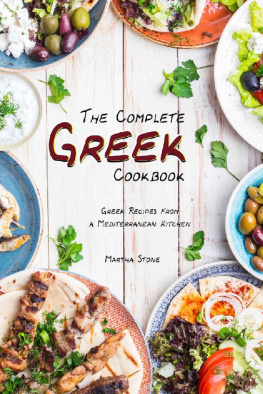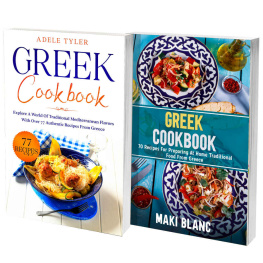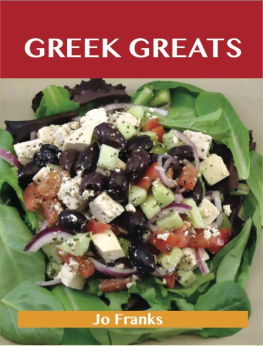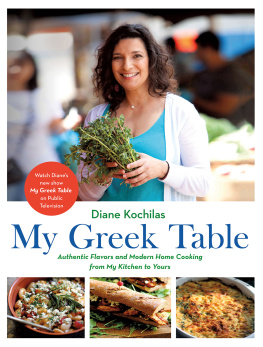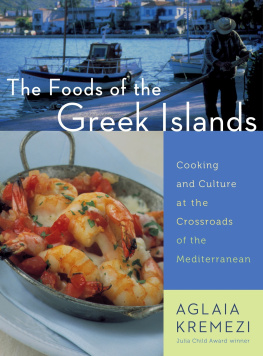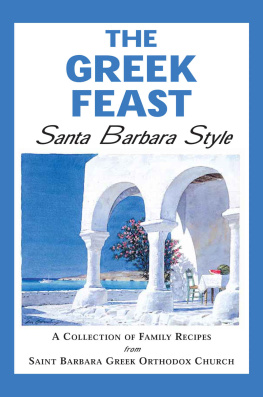





Contents



Growing up in a Greek household, first on a small Greek island and then in Australia, meant that I was constantly surrounded by family, friends, and food. There was always some cultural or religious occasion, such as a wedding, christening, or name day, to celebrate. Each invited guest would bring a dish, either sweet or savory. At these festivities I would spend most of my time near the kitchen so that I could see each special dish being unveiled. I was always amazed by the care each guest had taken to present the food in a visually spectacular way.
The women would gather in one room and converse on many subjects, but food was always top of the agenda. They would reminisce about Greece and exchange memories, both happy and sad. When food was discussed each dish would have a story attached to it. It was during these gatherings that I began to develop a deeper understanding and appreciation for these women and for Greek cuisine. I have included some of their stories in this book, as many of them are so intricately associated with dishes I grew up eating and still cook today.
Because eating at a Greek table is as much about ritual as it is about sustenance, before the meal there is always a blessing of the food, followed by the words Kalli orexi and Stin igia sas (Good appetite and To your health). And it wouldnt be a Greek meal without a toast with wine or ouzo.
In Greek cooking today, the influence of the ancients is still evident. Many of the same ingredients that the ancient Greeks prized are central to modern Greek cooking. Ingredients are handled with respect and presented with care, just as they were all those millennia ago. Perhaps the reason Greeks today treat the act of sharing food with often spiritual and philosophical significance comes from their roots. In ancient times Greeks never ate meat unless it had been sacrificed to a god, and certain vegetables were considered cleaner than others.
Much of the food prepared on the mainland by the ancient Greeks was relatively simple and minimally spiced. The concept of sweet and soursuch as vinegar or garos (fish sauce) combined with honeywas of great importance. Archestratus, renowned as the father of gastronomy and the writer of the first cookbook, took great care to follow this philosophy so as best to enhance the overall harmony of tastes and aromas.
The resulting Greek cuisine has been influencing the culinary traditions of other cultures for thousands of years. Many recipes with Turkish names have their origins in Greek cooking. The Romans also adopted and imitated Greek dishes, ingredients, and cooking styles after employing Athenian cooks and later procuring the services of Greek tutors for the education of their children. This ultimately resulted in Greek cuisine influencing some of the Italian and French culinary traditions.
Greeces more modern history has also made a deep impression of the way that Greek people eat. The Second World War was a time of great deprivation, and many people had to be inventive with the dishes they cooked, simply in order to survive. In the years that followed, manymy family includedleft their homeland to begin new lives in Australia. As well as suitcases filled with their beloved ingredients, they brought with them a notion central to Greek cuisine: kerasma, the sharing and offering of food to loved ones.
This book is as much about the importance of the family and friends who share our table as it is about food. I include here stories from my own familyabout what it is that makes them so uniquely Greek and how I have come to honor my Greek heritage. My mothers side of the family has had the strongest influence on me when it comes to food. When I cook I sense their spirit and energy guiding me to produce dishes that capture cultural traditions and family secrets.
Greek people are passionate about their food; they blossom like flowers when they are around it. They are so proud of their cuisine that the Greek postal service often releases postage stamps to showcase dishes and to share recipes with the rest of the world. And I am no exception!
When you try these recipes, I hope youll feel the same connection with Greece that I do.

A puppet from the Greek shadow theater, which is popular entertainment for children and adults alike. This characters name is Karakiozis.



At the Greek table, a salad is always served at the start of the meal, followed by the meze. Each region of Greece has a signature salad designed to capitalize on locally grown ingredients, such as tomatoes, beets, cucumbers, olives, pulses, anchovies, capers, caper leaves, rusks, fresh herbs, pomegranates, and wild greens. They also feature locally made products such as olive oil, red wine vinegar, a variety of cheeses and cured meats, and sausages. Some dips on the meze table, such as taramosalata, are also called salads. The components of each salad are so fresh and vibrant that the ingredients list is generally kept fairly short, giving each flavor the opportunity to shine.

Traditional Kalamata Salad
The traditional Kalamata salad, known in Greece as horiatiki salata (or villagers salad) when other ingredients such as bell pepper or purslane are added, comprises Kalamata olives, tomatoes, cucumber, Greek feta, and onion. Many people incorrectly call it a Greek salad and add other ingredients; however, I prefer the traditional blend and do not alter the quantities or compromise on the quality of the ingredients. I dont tend to add red wine vinegar to the salad, but you can if you like.
The word feta means slice. Most eateries in Greece therefore slice the feta rather than cut it into cubes, and place it on top of the salad just before serving. Serves 4
Next page

